Kuso (供僧) refers to a group of monks of Toji who were allowed to attend hyojo (評定, meetings) and conduct Buddhist services as members of monastic organizations, including Nijuikku-kata (廿一口方), Gakushu-kata (学衆方), and Chinjuhachimangu-kata (鎮守八幡宮方). The prescribed number of kuso varied depending on the organization, and a new kuso monk was chosen only when there was a vacancy.
In Nijuikku-kata, one of the monastic organizations of Toji, a kuso monk resigning from his post chose a candidate for the vacancy. After thoroughly examining the candidate’s kiyo (器用, endowments and abilities), the resigning kuso monk handed over his position to the candidate. The candidate was, however, not allowed to become a kuso monk until he gained hyojo approval. The document below was drawn up when Raigyo (頼暁) handed over his position to his pupil, Raihen (頼遍), in 1373:

When the candidate, who was often a pupil of the resigning kuso monk, was finally allowed to join kuso with the approval of hyojo, the other members of kuso wrote their signatures on a recommendation letter called kyojo (挙状). The kyojo was first sent to Ninnaji-no-miya (仁和寺宮), who had the authority to order Toji-choja (東寺長者, the head of Toji) to officially install a new member of kuso. It seems that the members of kuso could not solely be determined within the authority of Toji.

A monk who had been appointed as a new kuso member was required to hand in a written oath called ukebumi (請文), in which he promised to follow the rules as a member of the organization.

A kuso member who disobeyed the rules or acted against the operation policy of the organization (referred to as shumei (衆命)) would be punished and sometimes disowned.
The document below shows an example of disownment. According to the document, Gyochu-hoin (尭忠法印), Soju-sozu (宗寿僧都), and Gyozen-sozu (尭全僧都) attended a Buddhist service called Ninna-ji Denpo-e (仁和寺伝法会) without permission although it was prohibited by Gakushu-kata. As a result, Gakushu-kata drew up the document below stating the organization had disowned these three monks as their conduct was “prohibited.”

There is a document of Gakushu-kata stipulating the procedural rules for appointing its members. Item (13) of Box-shi is a record of hyojo held on October 11, 1329, in which the procedural rules for appointing leading members of the organization, referred to as gakushu, were decided.
The members of gakushu were not chosen by a member resigning from his position unlike kuso of Nijuikku-kata. Gakushu-kata, regarding a person’s kiyo (endowments and abilities) the most important, allowed anyone with prominent endowments and abilities to join the organization as a member of gakushu, including monks from other temples of the Shingon-sect, such as Ninna-ji (仁和寺) Temple and Daigo-ji (醍醐寺) Temple. This rule was very characteristic of Gakushu-kata, which emphasized education.

Although the rules for choosing new members of kuso or gakushu somewhat differed depending on the organization, the final decision was always made in hyojo. This indicates how independently each organization was operated.